Leadership Development, Theories, and HR's Role in the Garvey Group
VerifiedAdded on 2022/11/16
|17
|4328
|428
Report
AI Summary
This report provides an in-depth analysis of leadership development within the Garvey Group, a family-owned hotel and retail business. It distinguishes between leadership and management development, highlighting the importance of leadership skills for organizational success. The report examines various leadership theories, including transactional and leader-member exchange theories, and their application within the Group. It explores the organizational, social, environmental, and multicultural contexts influencing leadership development. Furthermore, the report emphasizes the crucial role of HR professionals in fostering effective leadership, detailing how they can collaborate with others to achieve organizational goals. The report covers topics like leadership styles, trait and situational approaches and how these can be utilized to enhance leadership capabilities. The report concludes with a summary of the key findings and recommendations for leadership development within the Garvey Group.
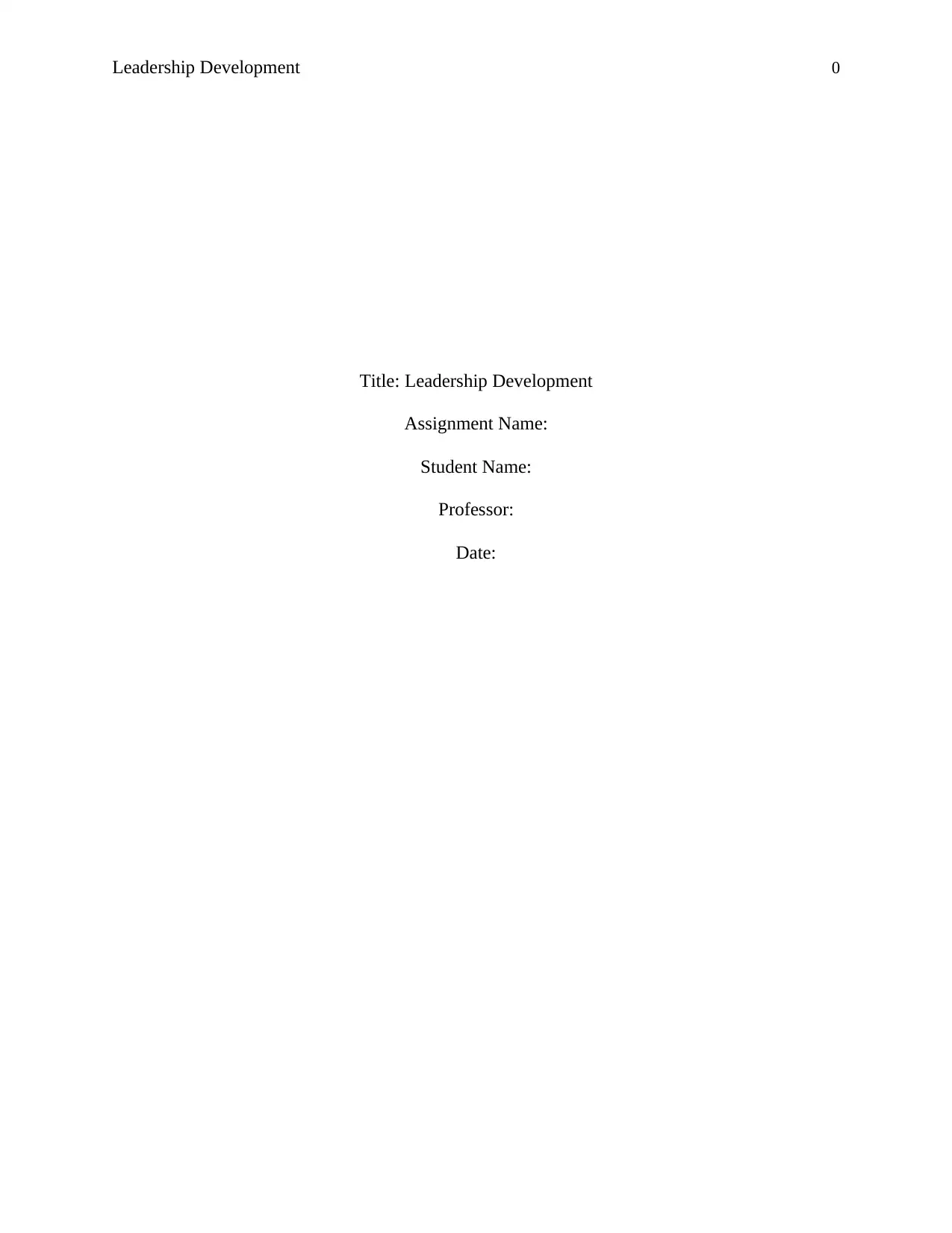
Leadership Development 0
Title: Leadership Development
Assignment Name:
Student Name:
Professor:
Date:
Title: Leadership Development
Assignment Name:
Student Name:
Professor:
Date:
Paraphrase This Document
Need a fresh take? Get an instant paraphrase of this document with our AI Paraphraser
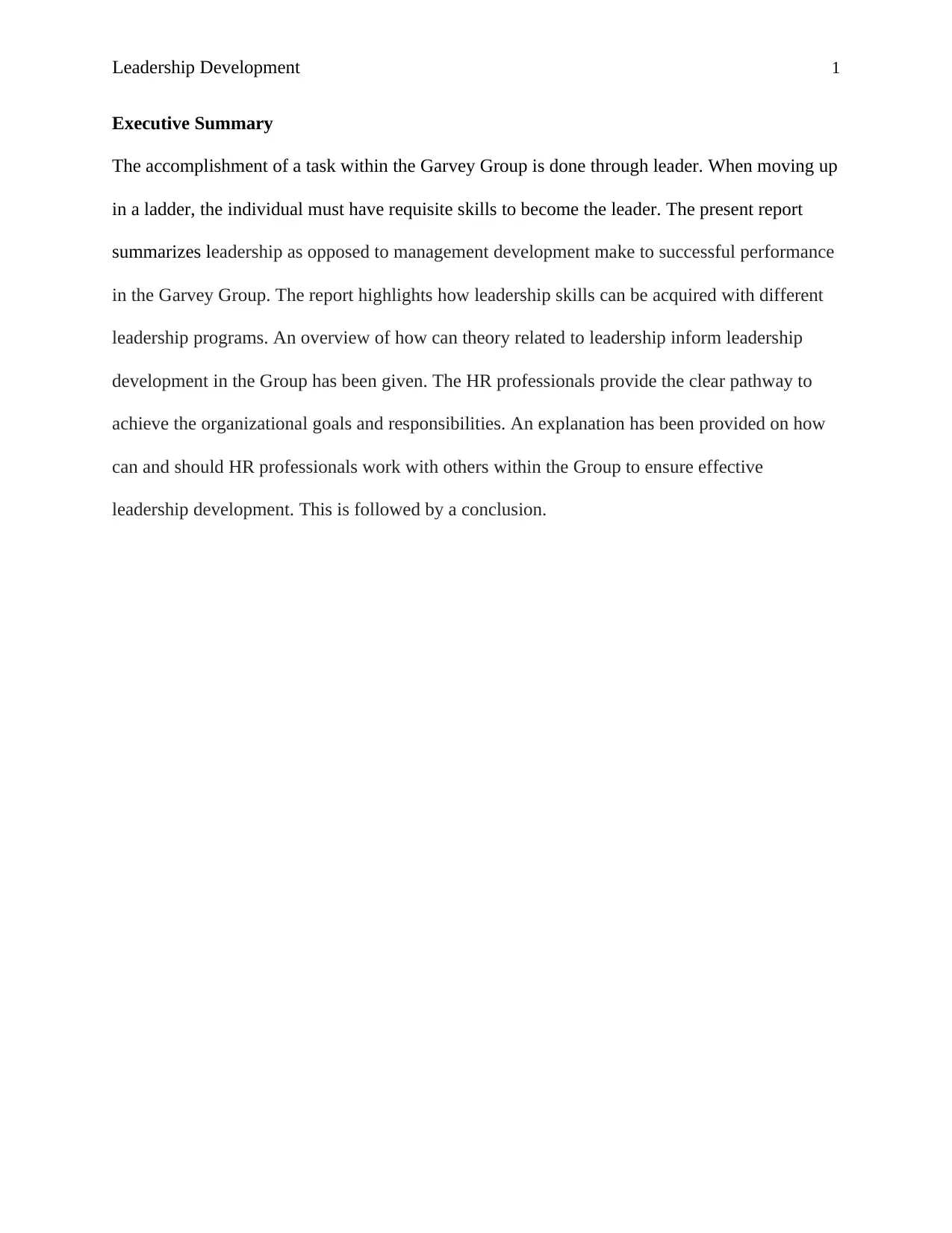
Leadership Development 1
Executive Summary
The accomplishment of a task within the Garvey Group is done through leader. When moving up
in a ladder, the individual must have requisite skills to become the leader. The present report
summarizes leadership as opposed to management development make to successful performance
in the Garvey Group. The report highlights how leadership skills can be acquired with different
leadership programs. An overview of how can theory related to leadership inform leadership
development in the Group has been given. The HR professionals provide the clear pathway to
achieve the organizational goals and responsibilities. An explanation has been provided on how
can and should HR professionals work with others within the Group to ensure effective
leadership development. This is followed by a conclusion.
Executive Summary
The accomplishment of a task within the Garvey Group is done through leader. When moving up
in a ladder, the individual must have requisite skills to become the leader. The present report
summarizes leadership as opposed to management development make to successful performance
in the Garvey Group. The report highlights how leadership skills can be acquired with different
leadership programs. An overview of how can theory related to leadership inform leadership
development in the Group has been given. The HR professionals provide the clear pathway to
achieve the organizational goals and responsibilities. An explanation has been provided on how
can and should HR professionals work with others within the Group to ensure effective
leadership development. This is followed by a conclusion.
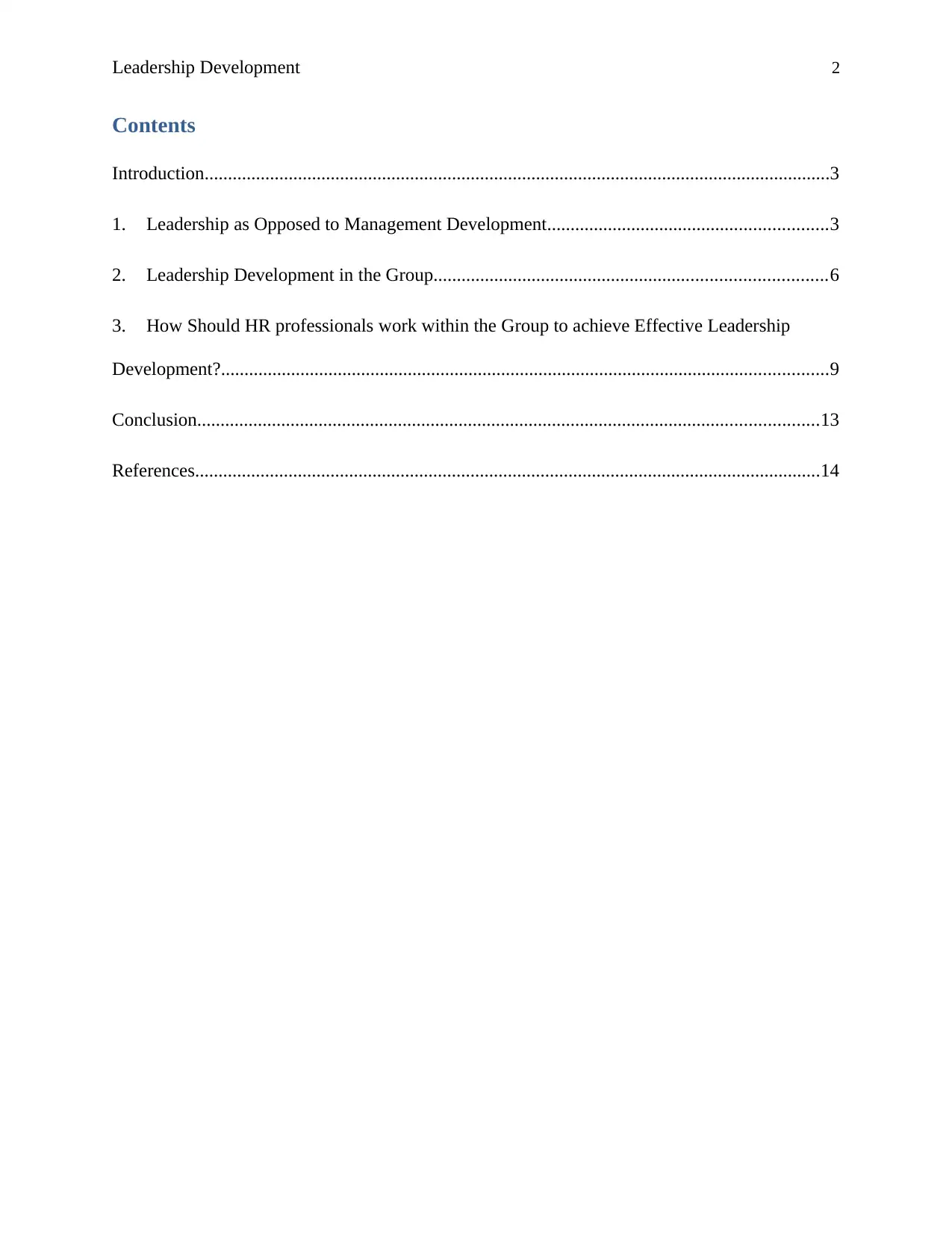
Leadership Development 2
Contents
Introduction......................................................................................................................................3
1. Leadership as Opposed to Management Development............................................................3
2. Leadership Development in the Group....................................................................................6
3. How Should HR professionals work within the Group to achieve Effective Leadership
Development?..................................................................................................................................9
Conclusion.....................................................................................................................................13
References......................................................................................................................................14
Contents
Introduction......................................................................................................................................3
1. Leadership as Opposed to Management Development............................................................3
2. Leadership Development in the Group....................................................................................6
3. How Should HR professionals work within the Group to achieve Effective Leadership
Development?..................................................................................................................................9
Conclusion.....................................................................................................................................13
References......................................................................................................................................14
⊘ This is a preview!⊘
Do you want full access?
Subscribe today to unlock all pages.

Trusted by 1+ million students worldwide
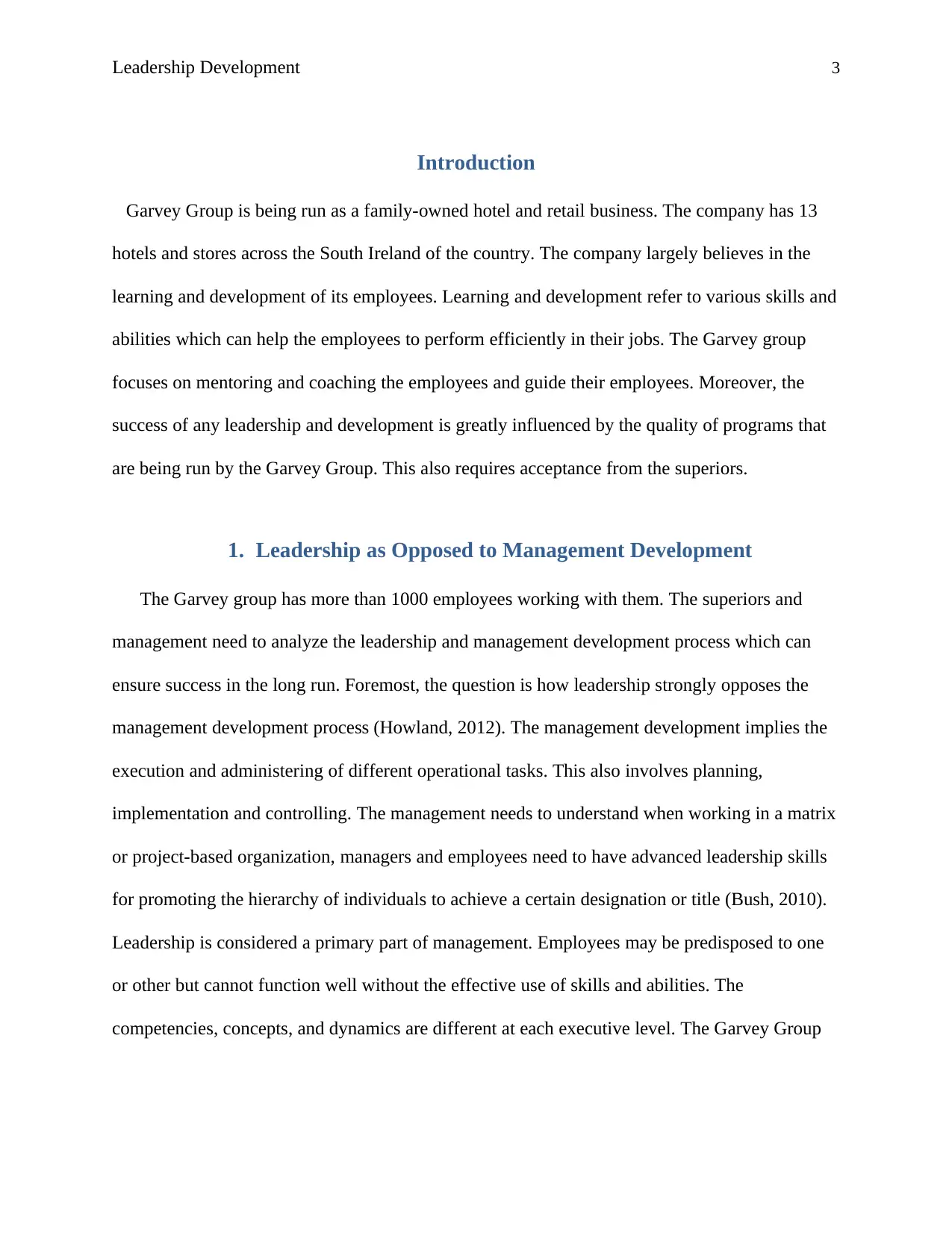
Leadership Development 3
Introduction
Garvey Group is being run as a family-owned hotel and retail business. The company has 13
hotels and stores across the South Ireland of the country. The company largely believes in the
learning and development of its employees. Learning and development refer to various skills and
abilities which can help the employees to perform efficiently in their jobs. The Garvey group
focuses on mentoring and coaching the employees and guide their employees. Moreover, the
success of any leadership and development is greatly influenced by the quality of programs that
are being run by the Garvey Group. This also requires acceptance from the superiors.
1. Leadership as Opposed to Management Development
The Garvey group has more than 1000 employees working with them. The superiors and
management need to analyze the leadership and management development process which can
ensure success in the long run. Foremost, the question is how leadership strongly opposes the
management development process (Howland, 2012). The management development implies the
execution and administering of different operational tasks. This also involves planning,
implementation and controlling. The management needs to understand when working in a matrix
or project-based organization, managers and employees need to have advanced leadership skills
for promoting the hierarchy of individuals to achieve a certain designation or title (Bush, 2010).
Leadership is considered a primary part of management. Employees may be predisposed to one
or other but cannot function well without the effective use of skills and abilities. The
competencies, concepts, and dynamics are different at each executive level. The Garvey Group
Introduction
Garvey Group is being run as a family-owned hotel and retail business. The company has 13
hotels and stores across the South Ireland of the country. The company largely believes in the
learning and development of its employees. Learning and development refer to various skills and
abilities which can help the employees to perform efficiently in their jobs. The Garvey group
focuses on mentoring and coaching the employees and guide their employees. Moreover, the
success of any leadership and development is greatly influenced by the quality of programs that
are being run by the Garvey Group. This also requires acceptance from the superiors.
1. Leadership as Opposed to Management Development
The Garvey group has more than 1000 employees working with them. The superiors and
management need to analyze the leadership and management development process which can
ensure success in the long run. Foremost, the question is how leadership strongly opposes the
management development process (Howland, 2012). The management development implies the
execution and administering of different operational tasks. This also involves planning,
implementation and controlling. The management needs to understand when working in a matrix
or project-based organization, managers and employees need to have advanced leadership skills
for promoting the hierarchy of individuals to achieve a certain designation or title (Bush, 2010).
Leadership is considered a primary part of management. Employees may be predisposed to one
or other but cannot function well without the effective use of skills and abilities. The
competencies, concepts, and dynamics are different at each executive level. The Garvey Group
Paraphrase This Document
Need a fresh take? Get an instant paraphrase of this document with our AI Paraphraser
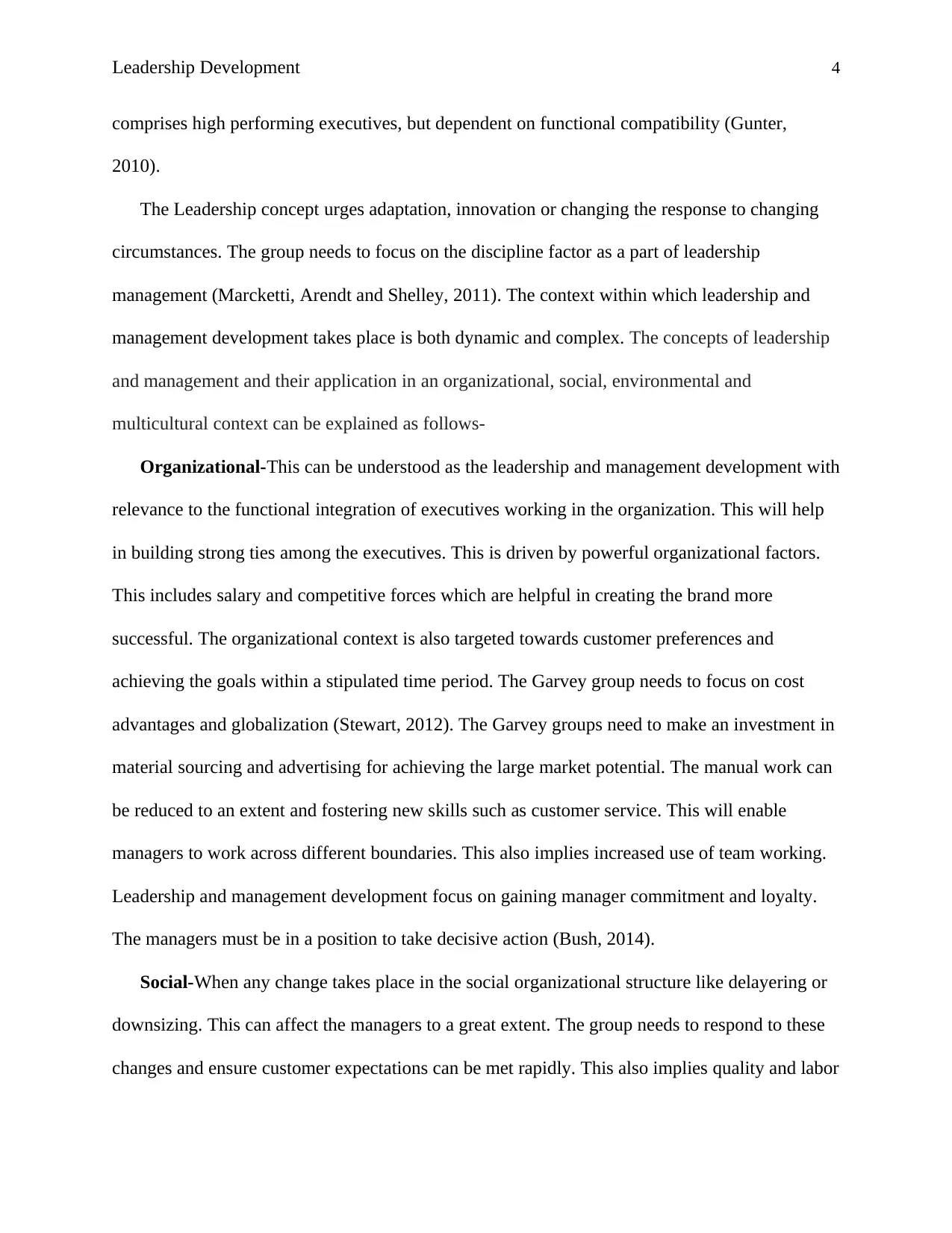
Leadership Development 4
comprises high performing executives, but dependent on functional compatibility (Gunter,
2010).
The Leadership concept urges adaptation, innovation or changing the response to changing
circumstances. The group needs to focus on the discipline factor as a part of leadership
management (Marcketti, Arendt and Shelley, 2011). The context within which leadership and
management development takes place is both dynamic and complex. The concepts of leadership
and management and their application in an organizational, social, environmental and
multicultural context can be explained as follows-
Organizational-This can be understood as the leadership and management development with
relevance to the functional integration of executives working in the organization. This will help
in building strong ties among the executives. This is driven by powerful organizational factors.
This includes salary and competitive forces which are helpful in creating the brand more
successful. The organizational context is also targeted towards customer preferences and
achieving the goals within a stipulated time period. The Garvey group needs to focus on cost
advantages and globalization (Stewart, 2012). The Garvey groups need to make an investment in
material sourcing and advertising for achieving the large market potential. The manual work can
be reduced to an extent and fostering new skills such as customer service. This will enable
managers to work across different boundaries. This also implies increased use of team working.
Leadership and management development focus on gaining manager commitment and loyalty.
The managers must be in a position to take decisive action (Bush, 2014).
Social-When any change takes place in the social organizational structure like delayering or
downsizing. This can affect the managers to a great extent. The group needs to respond to these
changes and ensure customer expectations can be met rapidly. This also implies quality and labor
comprises high performing executives, but dependent on functional compatibility (Gunter,
2010).
The Leadership concept urges adaptation, innovation or changing the response to changing
circumstances. The group needs to focus on the discipline factor as a part of leadership
management (Marcketti, Arendt and Shelley, 2011). The context within which leadership and
management development takes place is both dynamic and complex. The concepts of leadership
and management and their application in an organizational, social, environmental and
multicultural context can be explained as follows-
Organizational-This can be understood as the leadership and management development with
relevance to the functional integration of executives working in the organization. This will help
in building strong ties among the executives. This is driven by powerful organizational factors.
This includes salary and competitive forces which are helpful in creating the brand more
successful. The organizational context is also targeted towards customer preferences and
achieving the goals within a stipulated time period. The Garvey group needs to focus on cost
advantages and globalization (Stewart, 2012). The Garvey groups need to make an investment in
material sourcing and advertising for achieving the large market potential. The manual work can
be reduced to an extent and fostering new skills such as customer service. This will enable
managers to work across different boundaries. This also implies increased use of team working.
Leadership and management development focus on gaining manager commitment and loyalty.
The managers must be in a position to take decisive action (Bush, 2014).
Social-When any change takes place in the social organizational structure like delayering or
downsizing. This can affect the managers to a great extent. The group needs to respond to these
changes and ensure customer expectations can be met rapidly. This also implies quality and labor
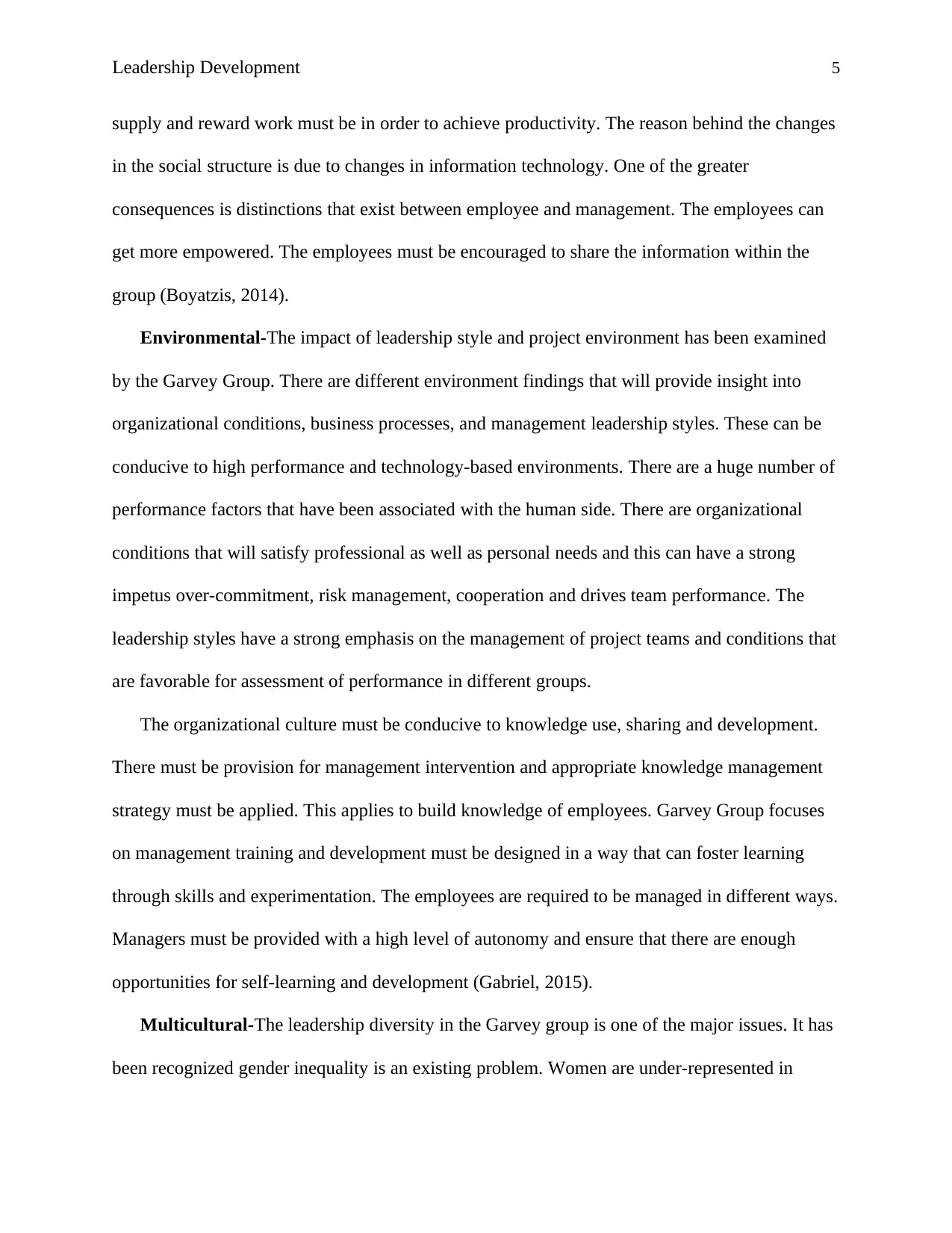
Leadership Development 5
supply and reward work must be in order to achieve productivity. The reason behind the changes
in the social structure is due to changes in information technology. One of the greater
consequences is distinctions that exist between employee and management. The employees can
get more empowered. The employees must be encouraged to share the information within the
group (Boyatzis, 2014).
Environmental-The impact of leadership style and project environment has been examined
by the Garvey Group. There are different environment findings that will provide insight into
organizational conditions, business processes, and management leadership styles. These can be
conducive to high performance and technology-based environments. There are a huge number of
performance factors that have been associated with the human side. There are organizational
conditions that will satisfy professional as well as personal needs and this can have a strong
impetus over-commitment, risk management, cooperation and drives team performance. The
leadership styles have a strong emphasis on the management of project teams and conditions that
are favorable for assessment of performance in different groups.
The organizational culture must be conducive to knowledge use, sharing and development.
There must be provision for management intervention and appropriate knowledge management
strategy must be applied. This applies to build knowledge of employees. Garvey Group focuses
on management training and development must be designed in a way that can foster learning
through skills and experimentation. The employees are required to be managed in different ways.
Managers must be provided with a high level of autonomy and ensure that there are enough
opportunities for self-learning and development (Gabriel, 2015).
Multicultural-The leadership diversity in the Garvey group is one of the major issues. It has
been recognized gender inequality is an existing problem. Women are under-represented in
supply and reward work must be in order to achieve productivity. The reason behind the changes
in the social structure is due to changes in information technology. One of the greater
consequences is distinctions that exist between employee and management. The employees can
get more empowered. The employees must be encouraged to share the information within the
group (Boyatzis, 2014).
Environmental-The impact of leadership style and project environment has been examined
by the Garvey Group. There are different environment findings that will provide insight into
organizational conditions, business processes, and management leadership styles. These can be
conducive to high performance and technology-based environments. There are a huge number of
performance factors that have been associated with the human side. There are organizational
conditions that will satisfy professional as well as personal needs and this can have a strong
impetus over-commitment, risk management, cooperation and drives team performance. The
leadership styles have a strong emphasis on the management of project teams and conditions that
are favorable for assessment of performance in different groups.
The organizational culture must be conducive to knowledge use, sharing and development.
There must be provision for management intervention and appropriate knowledge management
strategy must be applied. This applies to build knowledge of employees. Garvey Group focuses
on management training and development must be designed in a way that can foster learning
through skills and experimentation. The employees are required to be managed in different ways.
Managers must be provided with a high level of autonomy and ensure that there are enough
opportunities for self-learning and development (Gabriel, 2015).
Multicultural-The leadership diversity in the Garvey group is one of the major issues. It has
been recognized gender inequality is an existing problem. Women are under-represented in
⊘ This is a preview!⊘
Do you want full access?
Subscribe today to unlock all pages.

Trusted by 1+ million students worldwide
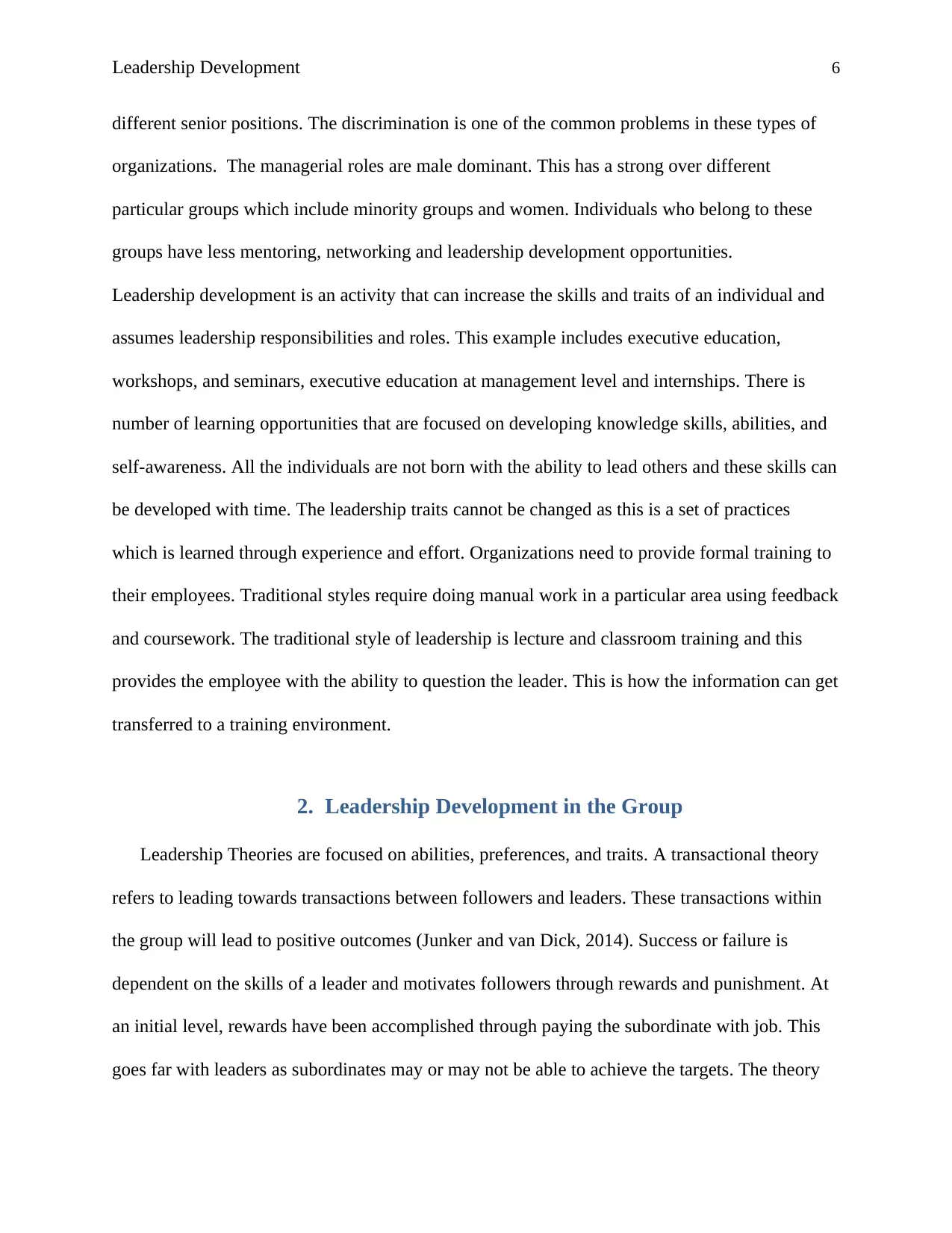
Leadership Development 6
different senior positions. The discrimination is one of the common problems in these types of
organizations. The managerial roles are male dominant. This has a strong over different
particular groups which include minority groups and women. Individuals who belong to these
groups have less mentoring, networking and leadership development opportunities.
Leadership development is an activity that can increase the skills and traits of an individual and
assumes leadership responsibilities and roles. This example includes executive education,
workshops, and seminars, executive education at management level and internships. There is
number of learning opportunities that are focused on developing knowledge skills, abilities, and
self-awareness. All the individuals are not born with the ability to lead others and these skills can
be developed with time. The leadership traits cannot be changed as this is a set of practices
which is learned through experience and effort. Organizations need to provide formal training to
their employees. Traditional styles require doing manual work in a particular area using feedback
and coursework. The traditional style of leadership is lecture and classroom training and this
provides the employee with the ability to question the leader. This is how the information can get
transferred to a training environment.
2. Leadership Development in the Group
Leadership Theories are focused on abilities, preferences, and traits. A transactional theory
refers to leading towards transactions between followers and leaders. These transactions within
the group will lead to positive outcomes (Junker and van Dick, 2014). Success or failure is
dependent on the skills of a leader and motivates followers through rewards and punishment. At
an initial level, rewards have been accomplished through paying the subordinate with job. This
goes far with leaders as subordinates may or may not be able to achieve the targets. The theory
different senior positions. The discrimination is one of the common problems in these types of
organizations. The managerial roles are male dominant. This has a strong over different
particular groups which include minority groups and women. Individuals who belong to these
groups have less mentoring, networking and leadership development opportunities.
Leadership development is an activity that can increase the skills and traits of an individual and
assumes leadership responsibilities and roles. This example includes executive education,
workshops, and seminars, executive education at management level and internships. There is
number of learning opportunities that are focused on developing knowledge skills, abilities, and
self-awareness. All the individuals are not born with the ability to lead others and these skills can
be developed with time. The leadership traits cannot be changed as this is a set of practices
which is learned through experience and effort. Organizations need to provide formal training to
their employees. Traditional styles require doing manual work in a particular area using feedback
and coursework. The traditional style of leadership is lecture and classroom training and this
provides the employee with the ability to question the leader. This is how the information can get
transferred to a training environment.
2. Leadership Development in the Group
Leadership Theories are focused on abilities, preferences, and traits. A transactional theory
refers to leading towards transactions between followers and leaders. These transactions within
the group will lead to positive outcomes (Junker and van Dick, 2014). Success or failure is
dependent on the skills of a leader and motivates followers through rewards and punishment. At
an initial level, rewards have been accomplished through paying the subordinate with job. This
goes far with leaders as subordinates may or may not be able to achieve the targets. The theory
Paraphrase This Document
Need a fresh take? Get an instant paraphrase of this document with our AI Paraphraser
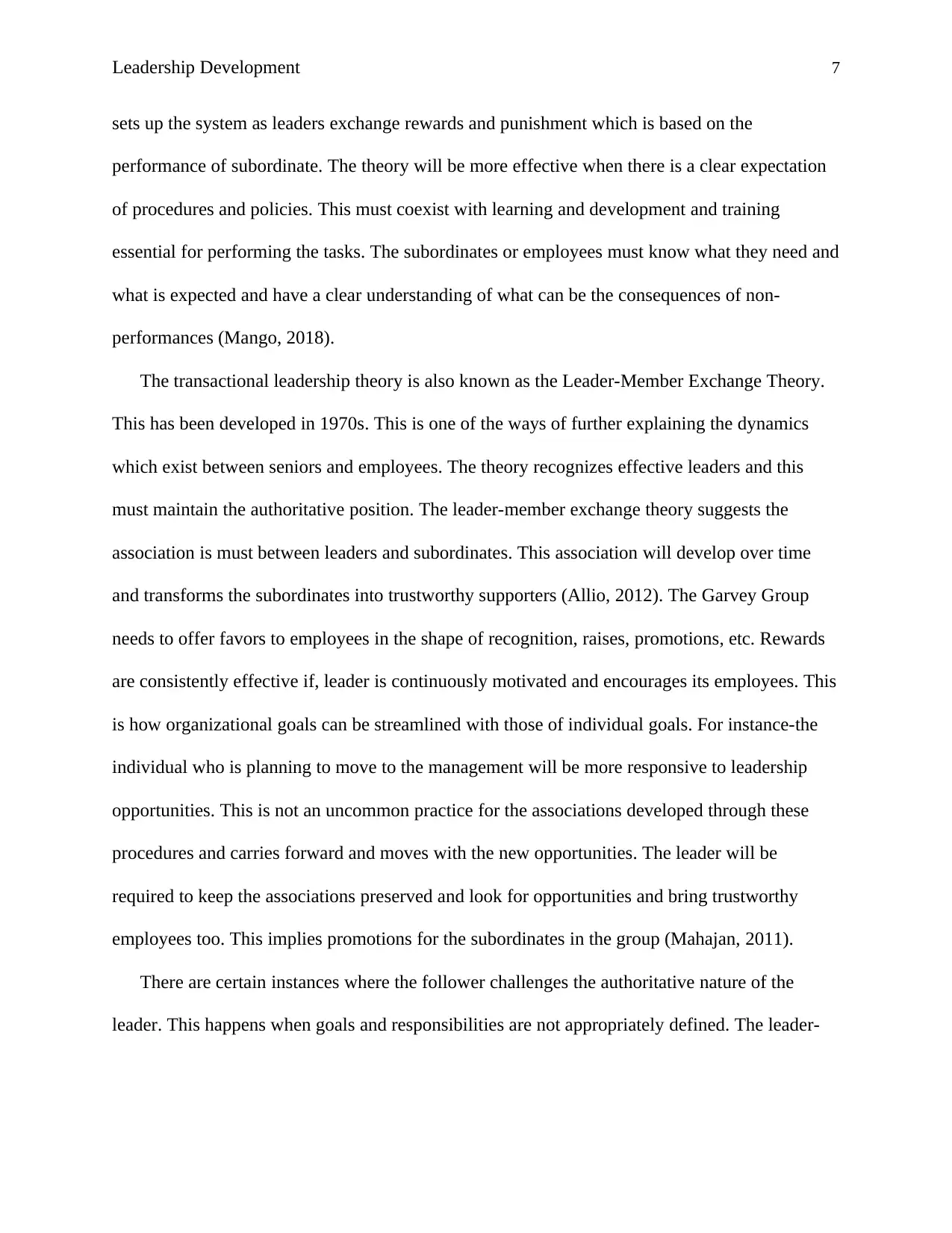
Leadership Development 7
sets up the system as leaders exchange rewards and punishment which is based on the
performance of subordinate. The theory will be more effective when there is a clear expectation
of procedures and policies. This must coexist with learning and development and training
essential for performing the tasks. The subordinates or employees must know what they need and
what is expected and have a clear understanding of what can be the consequences of non-
performances (Mango, 2018).
The transactional leadership theory is also known as the Leader-Member Exchange Theory.
This has been developed in 1970s. This is one of the ways of further explaining the dynamics
which exist between seniors and employees. The theory recognizes effective leaders and this
must maintain the authoritative position. The leader-member exchange theory suggests the
association is must between leaders and subordinates. This association will develop over time
and transforms the subordinates into trustworthy supporters (Allio, 2012). The Garvey Group
needs to offer favors to employees in the shape of recognition, raises, promotions, etc. Rewards
are consistently effective if, leader is continuously motivated and encourages its employees. This
is how organizational goals can be streamlined with those of individual goals. For instance-the
individual who is planning to move to the management will be more responsive to leadership
opportunities. This is not an uncommon practice for the associations developed through these
procedures and carries forward and moves with the new opportunities. The leader will be
required to keep the associations preserved and look for opportunities and bring trustworthy
employees too. This implies promotions for the subordinates in the group (Mahajan, 2011).
There are certain instances where the follower challenges the authoritative nature of the
leader. This happens when goals and responsibilities are not appropriately defined. The leader-
sets up the system as leaders exchange rewards and punishment which is based on the
performance of subordinate. The theory will be more effective when there is a clear expectation
of procedures and policies. This must coexist with learning and development and training
essential for performing the tasks. The subordinates or employees must know what they need and
what is expected and have a clear understanding of what can be the consequences of non-
performances (Mango, 2018).
The transactional leadership theory is also known as the Leader-Member Exchange Theory.
This has been developed in 1970s. This is one of the ways of further explaining the dynamics
which exist between seniors and employees. The theory recognizes effective leaders and this
must maintain the authoritative position. The leader-member exchange theory suggests the
association is must between leaders and subordinates. This association will develop over time
and transforms the subordinates into trustworthy supporters (Allio, 2012). The Garvey Group
needs to offer favors to employees in the shape of recognition, raises, promotions, etc. Rewards
are consistently effective if, leader is continuously motivated and encourages its employees. This
is how organizational goals can be streamlined with those of individual goals. For instance-the
individual who is planning to move to the management will be more responsive to leadership
opportunities. This is not an uncommon practice for the associations developed through these
procedures and carries forward and moves with the new opportunities. The leader will be
required to keep the associations preserved and look for opportunities and bring trustworthy
employees too. This implies promotions for the subordinates in the group (Mahajan, 2011).
There are certain instances where the follower challenges the authoritative nature of the
leader. This happens when goals and responsibilities are not appropriately defined. The leader-
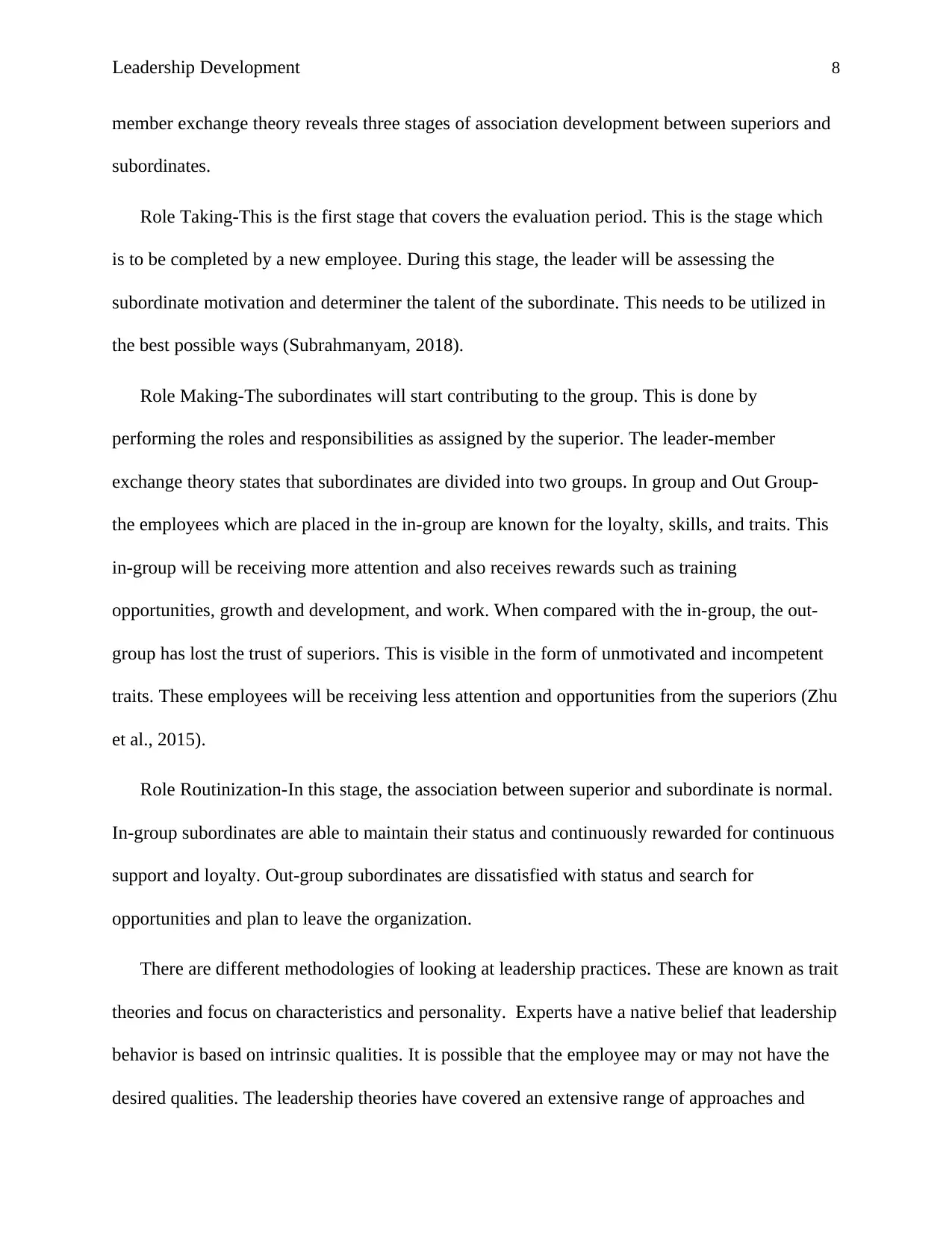
Leadership Development 8
member exchange theory reveals three stages of association development between superiors and
subordinates.
Role Taking-This is the first stage that covers the evaluation period. This is the stage which
is to be completed by a new employee. During this stage, the leader will be assessing the
subordinate motivation and determiner the talent of the subordinate. This needs to be utilized in
the best possible ways (Subrahmanyam, 2018).
Role Making-The subordinates will start contributing to the group. This is done by
performing the roles and responsibilities as assigned by the superior. The leader-member
exchange theory states that subordinates are divided into two groups. In group and Out Group-
the employees which are placed in the in-group are known for the loyalty, skills, and traits. This
in-group will be receiving more attention and also receives rewards such as training
opportunities, growth and development, and work. When compared with the in-group, the out-
group has lost the trust of superiors. This is visible in the form of unmotivated and incompetent
traits. These employees will be receiving less attention and opportunities from the superiors (Zhu
et al., 2015).
Role Routinization-In this stage, the association between superior and subordinate is normal.
In-group subordinates are able to maintain their status and continuously rewarded for continuous
support and loyalty. Out-group subordinates are dissatisfied with status and search for
opportunities and plan to leave the organization.
There are different methodologies of looking at leadership practices. These are known as trait
theories and focus on characteristics and personality. Experts have a native belief that leadership
behavior is based on intrinsic qualities. It is possible that the employee may or may not have the
desired qualities. The leadership theories have covered an extensive range of approaches and
member exchange theory reveals three stages of association development between superiors and
subordinates.
Role Taking-This is the first stage that covers the evaluation period. This is the stage which
is to be completed by a new employee. During this stage, the leader will be assessing the
subordinate motivation and determiner the talent of the subordinate. This needs to be utilized in
the best possible ways (Subrahmanyam, 2018).
Role Making-The subordinates will start contributing to the group. This is done by
performing the roles and responsibilities as assigned by the superior. The leader-member
exchange theory states that subordinates are divided into two groups. In group and Out Group-
the employees which are placed in the in-group are known for the loyalty, skills, and traits. This
in-group will be receiving more attention and also receives rewards such as training
opportunities, growth and development, and work. When compared with the in-group, the out-
group has lost the trust of superiors. This is visible in the form of unmotivated and incompetent
traits. These employees will be receiving less attention and opportunities from the superiors (Zhu
et al., 2015).
Role Routinization-In this stage, the association between superior and subordinate is normal.
In-group subordinates are able to maintain their status and continuously rewarded for continuous
support and loyalty. Out-group subordinates are dissatisfied with status and search for
opportunities and plan to leave the organization.
There are different methodologies of looking at leadership practices. These are known as trait
theories and focus on characteristics and personality. Experts have a native belief that leadership
behavior is based on intrinsic qualities. It is possible that the employee may or may not have the
desired qualities. The leadership theories have covered an extensive range of approaches and
⊘ This is a preview!⊘
Do you want full access?
Subscribe today to unlock all pages.

Trusted by 1+ million students worldwide
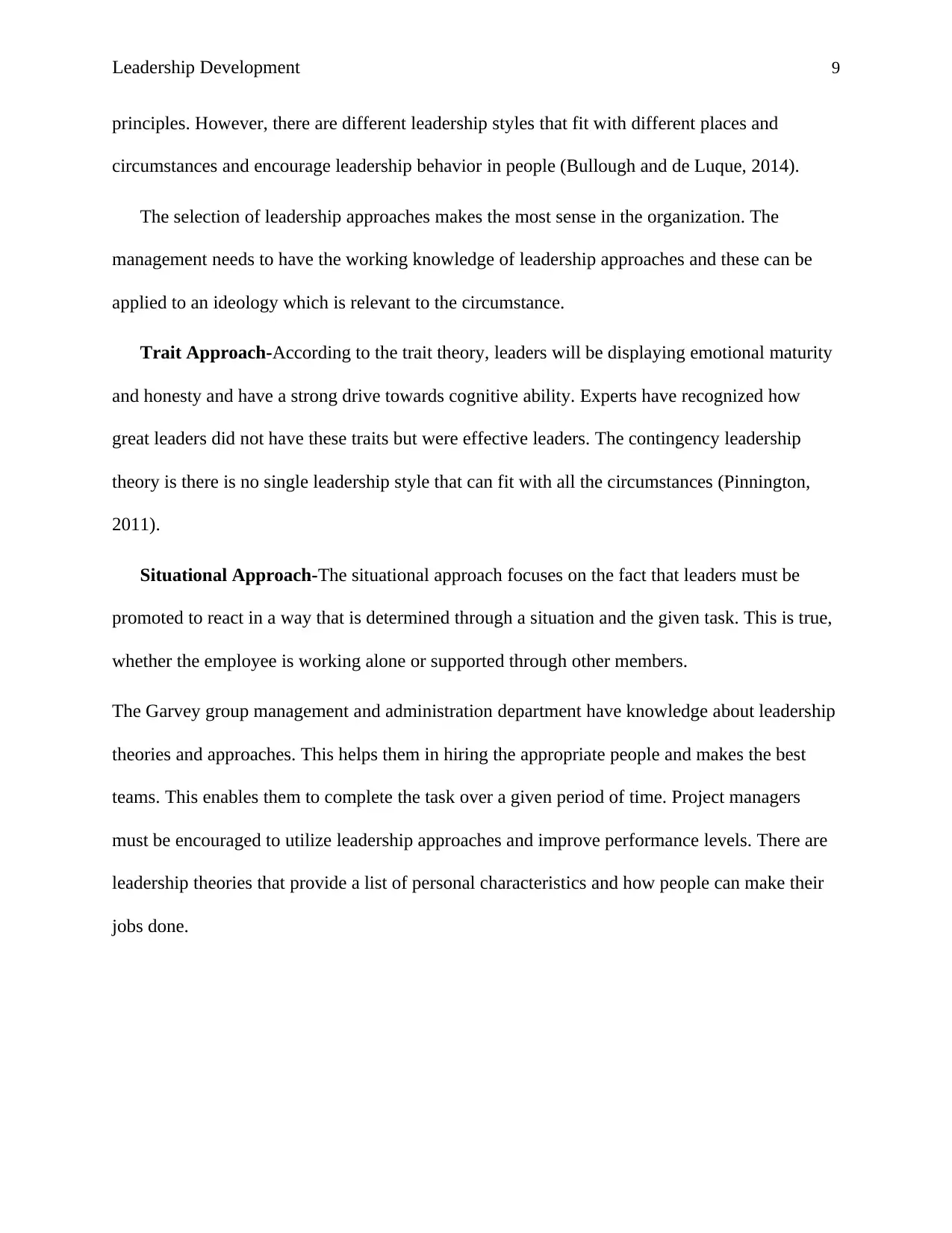
Leadership Development 9
principles. However, there are different leadership styles that fit with different places and
circumstances and encourage leadership behavior in people (Bullough and de Luque, 2014).
The selection of leadership approaches makes the most sense in the organization. The
management needs to have the working knowledge of leadership approaches and these can be
applied to an ideology which is relevant to the circumstance.
Trait Approach-According to the trait theory, leaders will be displaying emotional maturity
and honesty and have a strong drive towards cognitive ability. Experts have recognized how
great leaders did not have these traits but were effective leaders. The contingency leadership
theory is there is no single leadership style that can fit with all the circumstances (Pinnington,
2011).
Situational Approach-The situational approach focuses on the fact that leaders must be
promoted to react in a way that is determined through a situation and the given task. This is true,
whether the employee is working alone or supported through other members.
The Garvey group management and administration department have knowledge about leadership
theories and approaches. This helps them in hiring the appropriate people and makes the best
teams. This enables them to complete the task over a given period of time. Project managers
must be encouraged to utilize leadership approaches and improve performance levels. There are
leadership theories that provide a list of personal characteristics and how people can make their
jobs done.
principles. However, there are different leadership styles that fit with different places and
circumstances and encourage leadership behavior in people (Bullough and de Luque, 2014).
The selection of leadership approaches makes the most sense in the organization. The
management needs to have the working knowledge of leadership approaches and these can be
applied to an ideology which is relevant to the circumstance.
Trait Approach-According to the trait theory, leaders will be displaying emotional maturity
and honesty and have a strong drive towards cognitive ability. Experts have recognized how
great leaders did not have these traits but were effective leaders. The contingency leadership
theory is there is no single leadership style that can fit with all the circumstances (Pinnington,
2011).
Situational Approach-The situational approach focuses on the fact that leaders must be
promoted to react in a way that is determined through a situation and the given task. This is true,
whether the employee is working alone or supported through other members.
The Garvey group management and administration department have knowledge about leadership
theories and approaches. This helps them in hiring the appropriate people and makes the best
teams. This enables them to complete the task over a given period of time. Project managers
must be encouraged to utilize leadership approaches and improve performance levels. There are
leadership theories that provide a list of personal characteristics and how people can make their
jobs done.
Paraphrase This Document
Need a fresh take? Get an instant paraphrase of this document with our AI Paraphraser
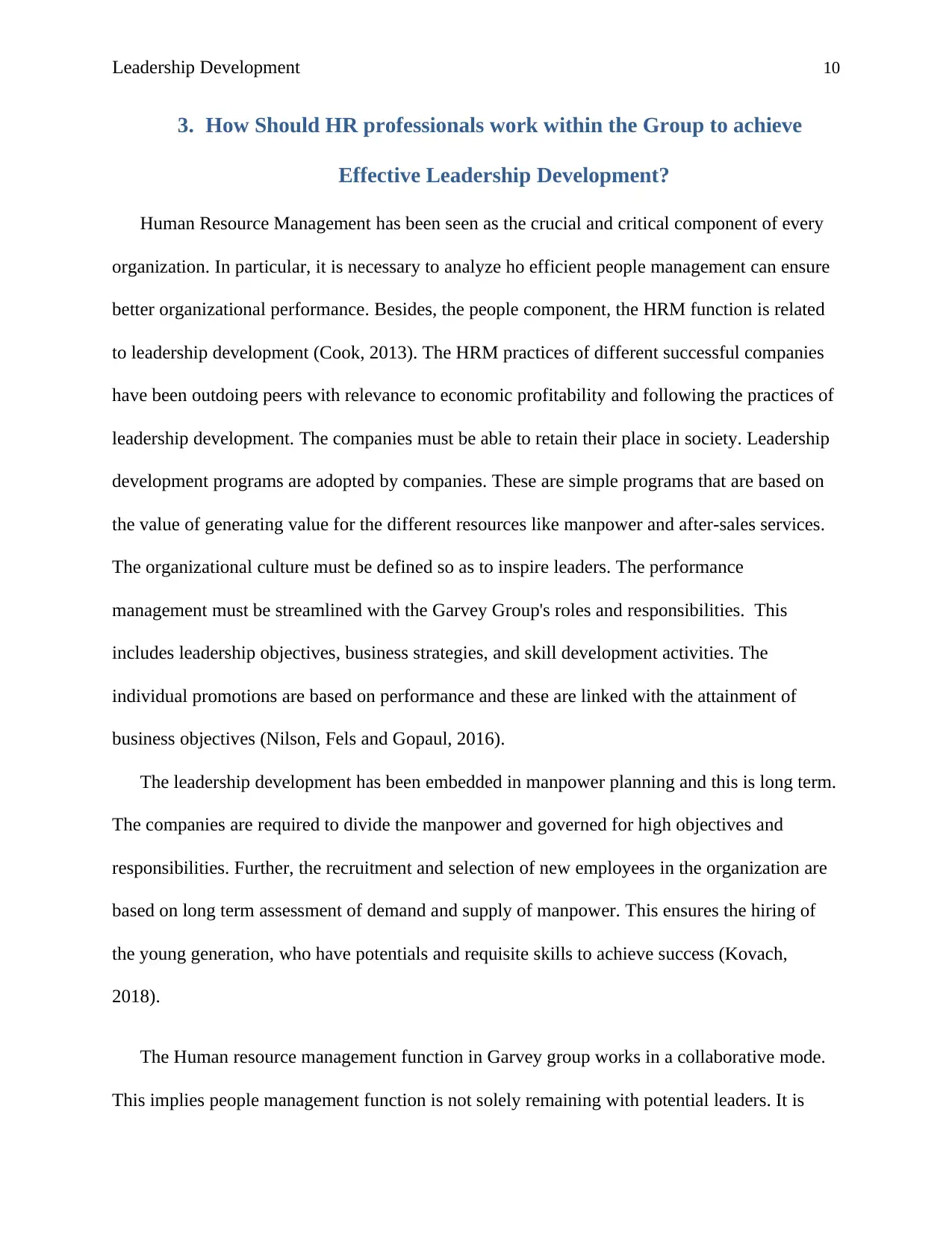
Leadership Development 10
3. How Should HR professionals work within the Group to achieve
Effective Leadership Development?
Human Resource Management has been seen as the crucial and critical component of every
organization. In particular, it is necessary to analyze ho efficient people management can ensure
better organizational performance. Besides, the people component, the HRM function is related
to leadership development (Cook, 2013). The HRM practices of different successful companies
have been outdoing peers with relevance to economic profitability and following the practices of
leadership development. The companies must be able to retain their place in society. Leadership
development programs are adopted by companies. These are simple programs that are based on
the value of generating value for the different resources like manpower and after-sales services.
The organizational culture must be defined so as to inspire leaders. The performance
management must be streamlined with the Garvey Group's roles and responsibilities. This
includes leadership objectives, business strategies, and skill development activities. The
individual promotions are based on performance and these are linked with the attainment of
business objectives (Nilson, Fels and Gopaul, 2016).
The leadership development has been embedded in manpower planning and this is long term.
The companies are required to divide the manpower and governed for high objectives and
responsibilities. Further, the recruitment and selection of new employees in the organization are
based on long term assessment of demand and supply of manpower. This ensures the hiring of
the young generation, who have potentials and requisite skills to achieve success (Kovach,
2018).
The Human resource management function in Garvey group works in a collaborative mode.
This implies people management function is not solely remaining with potential leaders. It is
3. How Should HR professionals work within the Group to achieve
Effective Leadership Development?
Human Resource Management has been seen as the crucial and critical component of every
organization. In particular, it is necessary to analyze ho efficient people management can ensure
better organizational performance. Besides, the people component, the HRM function is related
to leadership development (Cook, 2013). The HRM practices of different successful companies
have been outdoing peers with relevance to economic profitability and following the practices of
leadership development. The companies must be able to retain their place in society. Leadership
development programs are adopted by companies. These are simple programs that are based on
the value of generating value for the different resources like manpower and after-sales services.
The organizational culture must be defined so as to inspire leaders. The performance
management must be streamlined with the Garvey Group's roles and responsibilities. This
includes leadership objectives, business strategies, and skill development activities. The
individual promotions are based on performance and these are linked with the attainment of
business objectives (Nilson, Fels and Gopaul, 2016).
The leadership development has been embedded in manpower planning and this is long term.
The companies are required to divide the manpower and governed for high objectives and
responsibilities. Further, the recruitment and selection of new employees in the organization are
based on long term assessment of demand and supply of manpower. This ensures the hiring of
the young generation, who have potentials and requisite skills to achieve success (Kovach,
2018).
The Human resource management function in Garvey group works in a collaborative mode.
This implies people management function is not solely remaining with potential leaders. It is
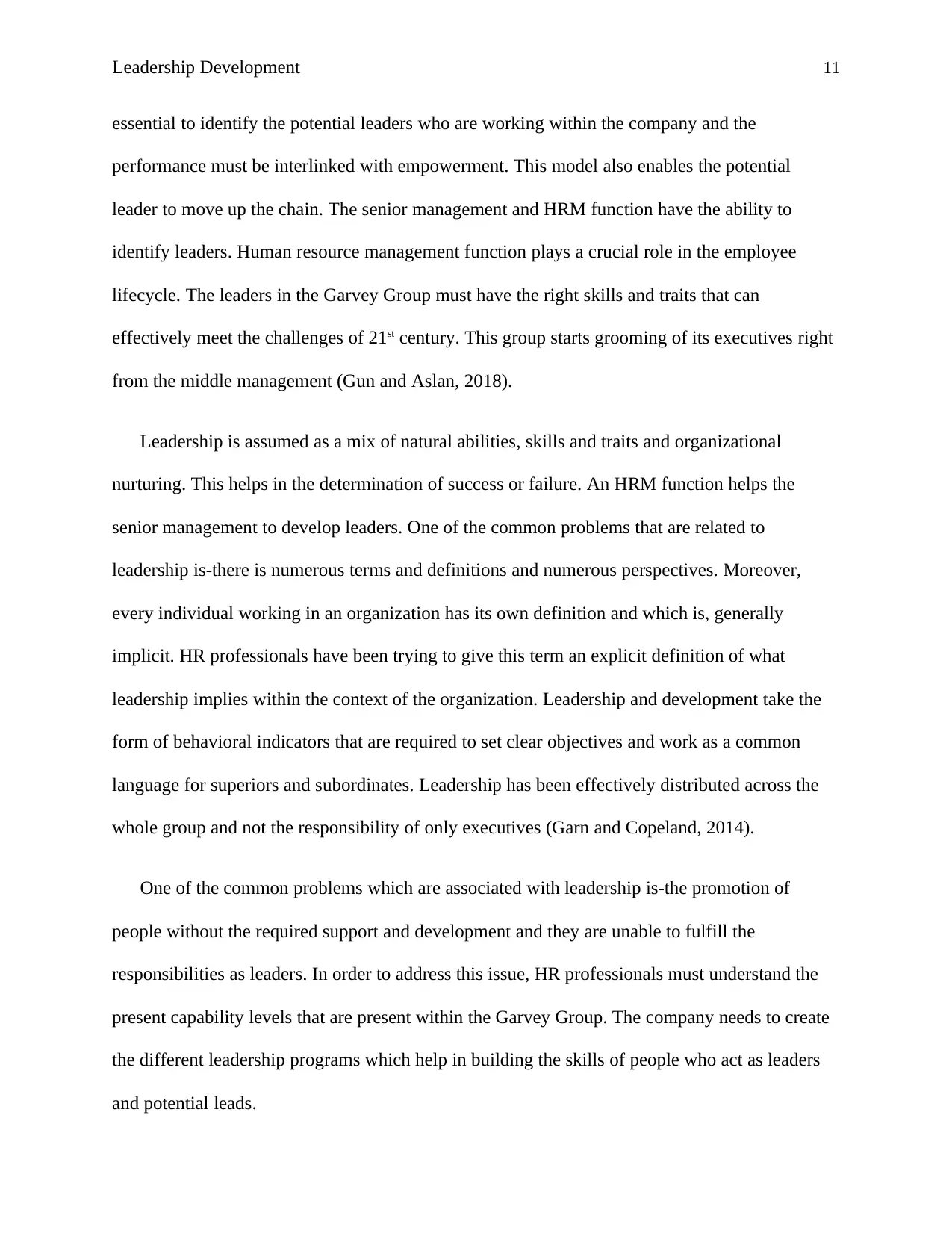
Leadership Development 11
essential to identify the potential leaders who are working within the company and the
performance must be interlinked with empowerment. This model also enables the potential
leader to move up the chain. The senior management and HRM function have the ability to
identify leaders. Human resource management function plays a crucial role in the employee
lifecycle. The leaders in the Garvey Group must have the right skills and traits that can
effectively meet the challenges of 21st century. This group starts grooming of its executives right
from the middle management (Gun and Aslan, 2018).
Leadership is assumed as a mix of natural abilities, skills and traits and organizational
nurturing. This helps in the determination of success or failure. An HRM function helps the
senior management to develop leaders. One of the common problems that are related to
leadership is-there is numerous terms and definitions and numerous perspectives. Moreover,
every individual working in an organization has its own definition and which is, generally
implicit. HR professionals have been trying to give this term an explicit definition of what
leadership implies within the context of the organization. Leadership and development take the
form of behavioral indicators that are required to set clear objectives and work as a common
language for superiors and subordinates. Leadership has been effectively distributed across the
whole group and not the responsibility of only executives (Garn and Copeland, 2014).
One of the common problems which are associated with leadership is-the promotion of
people without the required support and development and they are unable to fulfill the
responsibilities as leaders. In order to address this issue, HR professionals must understand the
present capability levels that are present within the Garvey Group. The company needs to create
the different leadership programs which help in building the skills of people who act as leaders
and potential leads.
essential to identify the potential leaders who are working within the company and the
performance must be interlinked with empowerment. This model also enables the potential
leader to move up the chain. The senior management and HRM function have the ability to
identify leaders. Human resource management function plays a crucial role in the employee
lifecycle. The leaders in the Garvey Group must have the right skills and traits that can
effectively meet the challenges of 21st century. This group starts grooming of its executives right
from the middle management (Gun and Aslan, 2018).
Leadership is assumed as a mix of natural abilities, skills and traits and organizational
nurturing. This helps in the determination of success or failure. An HRM function helps the
senior management to develop leaders. One of the common problems that are related to
leadership is-there is numerous terms and definitions and numerous perspectives. Moreover,
every individual working in an organization has its own definition and which is, generally
implicit. HR professionals have been trying to give this term an explicit definition of what
leadership implies within the context of the organization. Leadership and development take the
form of behavioral indicators that are required to set clear objectives and work as a common
language for superiors and subordinates. Leadership has been effectively distributed across the
whole group and not the responsibility of only executives (Garn and Copeland, 2014).
One of the common problems which are associated with leadership is-the promotion of
people without the required support and development and they are unable to fulfill the
responsibilities as leaders. In order to address this issue, HR professionals must understand the
present capability levels that are present within the Garvey Group. The company needs to create
the different leadership programs which help in building the skills of people who act as leaders
and potential leads.
⊘ This is a preview!⊘
Do you want full access?
Subscribe today to unlock all pages.

Trusted by 1+ million students worldwide
1 out of 17
Related Documents
Your All-in-One AI-Powered Toolkit for Academic Success.
+13062052269
info@desklib.com
Available 24*7 on WhatsApp / Email
![[object Object]](/_next/static/media/star-bottom.7253800d.svg)
Unlock your academic potential
Copyright © 2020–2025 A2Z Services. All Rights Reserved. Developed and managed by ZUCOL.





